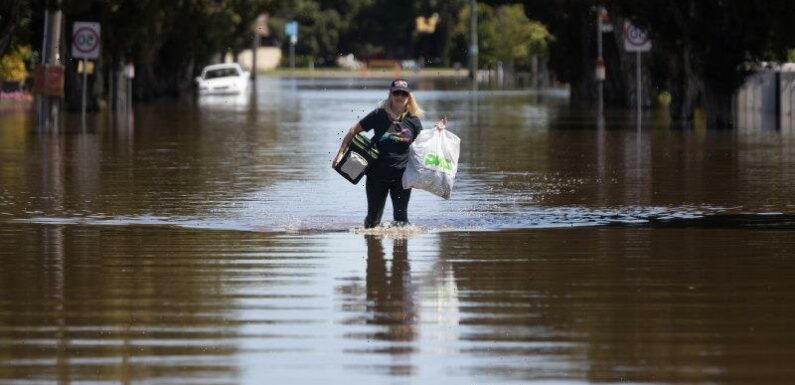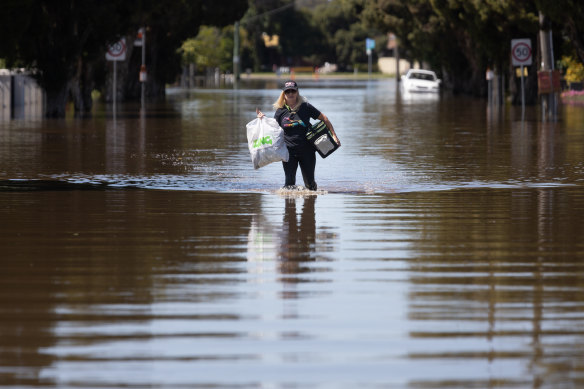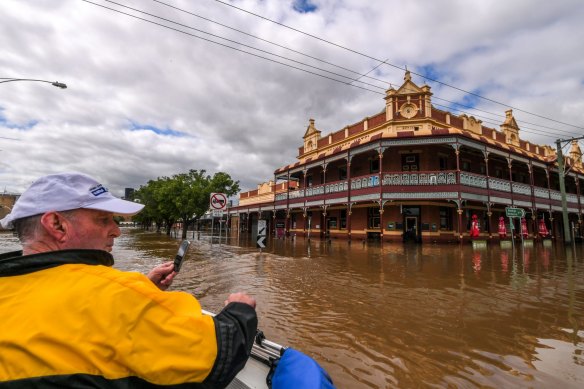
The floods that we have witnessed over the past few days are a sobering reminder of how our lives are subject to natural forces that are largely beyond our control. For most of us, such floods will be front-of-mind for only a few days.
When the floodwaters recede, we will become distracted by other world events, by other sequences of dramatic photos. But those caught up directly in the floods will not be able to move on so quickly. Such floods can have a devastating and long-term impact on mental and financial health. Their lives may be forever altered.
A woman carries her belongings through the floodwater in Shepparton South.Credit:Jason South
So why do these events keep happening? Why can’t we learn from past events and just fix things up so that we can all be safe? Well, as someone who has spent the past 40 years investigating flood behaviour, I can say with confidence that we can never hope to prevent floods – at least not the major ones like we have seen all along the east coast of Australia this year – all we can hope to do is learn how to better live with them.
It is common in the immediate aftermath of these events to look for someone to blame. It would be nice to think that our current disaster is the result of negligence somehow, and that we can seek compensation. I am aware, for example, of the concerns regarding the flood wall that was built to protect Flemington racetrack from inundation.
Well, I can think of several reasons why such a wall might have “unintended consequences” on neighbouring properties, but I can also think of several equally good reasons why it may not have had any adverse impacts. All we can be sure of at this point in time is that the original development would have been scrutinised carefully when first proposed, and if there are any lessons to be learned then they won’t be quick or easy to find.
The immediate cause of the recent floods is simple: a lot of rain has fallen in a short period. But there are other factors at play here, some just a random result of Mother Nature and others the result of human activity. We are in our third back-to-back La Niña season and the catchments are already sodden. Soils cannot absorb more rainfall and almost all rainfall quickly appears as flood runoff.
Flood magnitude also depends on exactly where in the catchment most rain falls, and whether the most intense rainfalls occur over a few hours or a few days. We have greatly modified the natural landscape, and almost all these changes have tended to make floods worse: we have cleared forests, channelised rivers and creeks, reduced the ability of floodplains to store water, and made large sections of our urban areas impervious.
We like to think dams and levees keep us safe from floods, but the reality is that they tend to engender a false sense of security as there always comes a point where the flood capacity of these structures is exceeded. So yes, dams and levees protect us from small floods, but they can make the consequences of large floods worse as we are encouraged to extend our cities and towns into floodplains that are best avoided.
It is impossible to think about the “unprecedented” nature of our recent floods without mentioning the climate crisis. In Victoria we are faced with a double whammy of climate adversity: under a warming climate, not only will our big floods get bigger, but our small floods will get smaller. Larger floods mean that the threats to life and property will increase over time, but smaller floods will reduce the essential inflows to dams that our water supplies rely on.
The Victorian government has invested considerable resources over the past 10 years improving the information and modelling tools available to assist planning and flood forecasting. But the vexing problem facing us here is that all our modelling is based on historical evidence, and this is increasingly irrelevant to future conditions.
Flooding in the town of Rochester in central Victoria.Credit:Justin McManus
The floods that have occurred over the past few days in northern Victoria are indeed extreme, and a back-of-the-envelope calculation suggests that the worst flooding might approach the fabled status of the “100-year” flood (a flood which has a 1 per cent chance of occurring in any one year).
However, under the current trajectory of carbon emissions the probability of such event occurring in the year 2100 will double.
Learning to live with floods means looking for “nature-based” solutions to help. Rather than building higher flood protections works and preventing floodwater moving onto floodplains, we can look for opportunities to encourage floodwaters to move into areas that would benefit from the inundation. Many native tree species and water-dependent flora and fauna depend on regular flooding. Floodwaters bring essential nutrients to riverine environments and provide triggers for reproduction and migration.
Changing our mindset from seeing floods only as a “problem” to being an “ecological service” will help us find locations where we can store water on the floodplain. This might involve changing land use in some areas or lowering productivity in others, but this is likely to cost less than building engineering solutions. Such changes will certainly bring much-needed biodiversity benefits and will reduce the impacts of floods on downstream communities.
So, as a hydrologist, I think the recent floods are a reminder that we are facing two gnarly challenges: we need to learn how to better live with floods, and we urgently need to reduce our carbon emissions.
Most Viewed in National
From our partners
Source: Read Full Article

